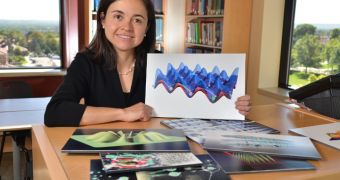Physicists have been fascinated by the behavior of ultra-cold atoms for many years, but understanding it has proven elusive. New research conducted by theoretical physicist Ana Maria Rey seeks to model how ultra-cold atoms interact, in the hopes of bringing forth new generations of superconducting materials, quantum devices and other innovations.
Figuring out how electrons interact in these atoms could boost our knowledge of condensed matter physics, and could also lead to a deeper understanding of quantum mechanics. The latter is a theory on how elementary particles interact at a very small scale, where Newtonian physics no longer applies.
The idea is to use ultra-cold atoms to construct a series of materials that do not exist in nature, but which can be used to explain materials that exist in nature, but are poorly understood. Such research could lead to the development of advanced precision measurement and quantum information devices.
Ana Maria Rey is the recipient of a $625,000 (461,600 euro) grant from the US National Science Foundation (NSF), also called the MacArthur fellowship, or the genius grant. This award only goes to researchers who have exhibited the greatest dedication, and obtained the best results, in their fields.
Rey holds an appointment as a research assistant professor with the Department of Physics at the University of Colorado in Boulder (UCB). She also works at JILA (the former Joint Institute for Laboratory Astrophysics), a collaboration between UCB and the US National Institute of Standards and Technology (NIST).
“Electrons in solids can exhibit rich behavior, complex behavior, that we do not understand. This behavior comes from interactions of many electrons. When the electrons in the solids interact and see other electrons, the laws of quantum mechanics govern how they behave,” she explains.
“This is very complicated behavior. This behavior is so complex that even a classical computer cannot solve it,” Rey adds. Normal computers can easily reach their processing limits when made to analyze how multiple atoms interact.
Since arriving at JILA, in 2008, the researcher has received an additional $500,000 (360,300 euros) to create models of ultra-cold atoms and polar molecules. Rey and her team are currently using these funds to develop synthetic materials by trapping atoms inside light beams.
These studies are believed to lay the groundwork for the creation of superconducting materials that work at room temperature. “Nowadays you have to cool the materials down, which is very expensive. If we don't have to cool them down, everything that uses superconductivity can be made much less expensively,” Rey concludes.

 14 DAY TRIAL //
14 DAY TRIAL //